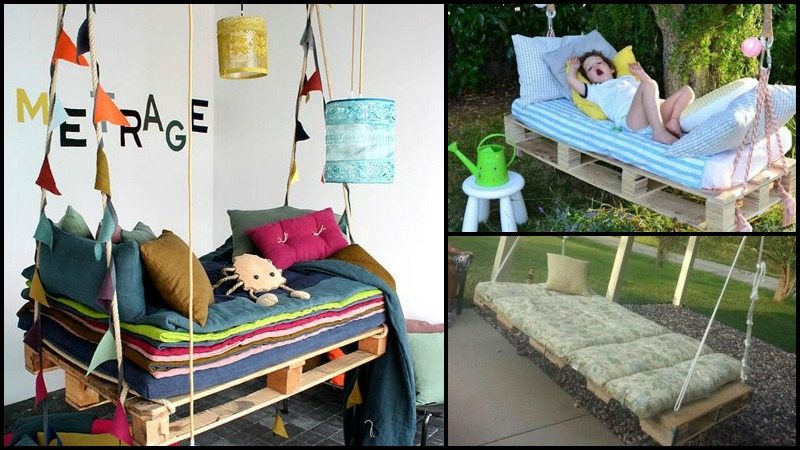
If your idea of relaxing outdoors is lying on a daybed or getting lulled to the gentle sway of a hammock then this DIY pallet swing bed is the perfect project for you. It’s easy, it’s cheap, and it’s great to have under a shade on pleasantly warm days.
Why Use Pallet as a Swing Bed?
There are many reasons to use a pallet as a swing bed. For one, pallets are relatively sturdy and can support a good amount of weight. Additionally, they are easy to find and usually inexpensive.
Additionally, pallets can be easily decorated or left plain, depending on your preference. You can upcycle an old pallet into a swing bed for your porch or backyard.
This is a great way to recycle and repurpose an otherwise unused item. You can use the pallet as is, or you can add some cushions or pillows to make it more comfortable. Either way, you’ll have a great place to relax and enjoy the outdoors.
Repurposing unused items like pallets is an excellent way to contribute to sustainability efforts while creating functional and aesthetically pleasing pieces for your home or outdoor space. With a little creativity and effort, you can transform a simple pallet into a versatile and stylish addition to your decor. Whether you choose to use the pallet as is or customize it with cushions and pillows, you’ll create a cozy and inviting spot to unwind and enjoy the outdoors.
Using a pallet as a seating or lounging area offers several benefits beyond its eco-friendly appeal. Pallets are typically sturdy and durable, making them suitable for outdoor use and able to withstand various weather conditions. Their simple and rustic appearance adds character to any space, and they can be easily personalized to match your style preferences.
If you prefer a minimalist look, you can leave the pallet as is, showcasing its natural wood texture and grain. A coat of outdoor sealant or paint can help protect the wood and enhance its appearance while maintaining its rustic charm. Alternatively, you can add cushions or pillows to the pallet to create a more comfortable seating area. Outdoor cushions or weather-resistant pillows not only provide extra comfort but also add color and visual interest to the space.
By repurposing a pallet into outdoor seating, you’re not only giving new life to a discarded item but also reducing waste and conserving resources. Pallets are often discarded after they’ve served their original purpose, contributing to landfill waste and environmental degradation. By repurposing them into functional furniture pieces, you’re diverting them from the waste stream and giving them a second chance at usefulness.
In addition to its environmental benefits, repurposing a pallet into outdoor seating allows you to exercise your creativity and DIY skills. Whether you’re a seasoned crafter or a novice DIY enthusiast, working with pallets offers endless possibilities for customization and personalization. You can paint or stain the wood to match your existing decor, or add decorative elements like stenciled designs or patterned upholstery for a unique touch.
Creating a seating area with pallets also provides a cost-efficient alternative to purchasing new outdoor furniture. Pallets are often available for free or at a low cost from local businesses or recycling centres, making them an affordable option for DIY projects. With some basic tools and materials, you can transform a pallet into a stylish and functional seating solution for your outdoor space without breaking the bank.
Repurposing a pallet into outdoor seating is a great way to recycle and repurpose an otherwise unused item while creating a cozy and inviting spot to relax and enjoy the outdoors. Whether you choose to use the pallet as is or customize it with cushions and pillows, you’ll create a sustainable and stylish seating solution that reflects your style and values.
So why not give it a try and turn a simple pallet into a beautiful and functional addition to your outdoor oasis?

How to Assemble the Pallet Swing Bed?
1. Start by finding a pallet, your best bet is to check your local hardware store. You can usually find pallets there, or you can order them online. Make sure you get a pallet that is the right size for your needs.
2. Once you have your pallet, lay it down on a flat surface and make sure that it is level. If it is not level, you can use some shims to level it out. Once your pallet is level, you can proceed to the next step.
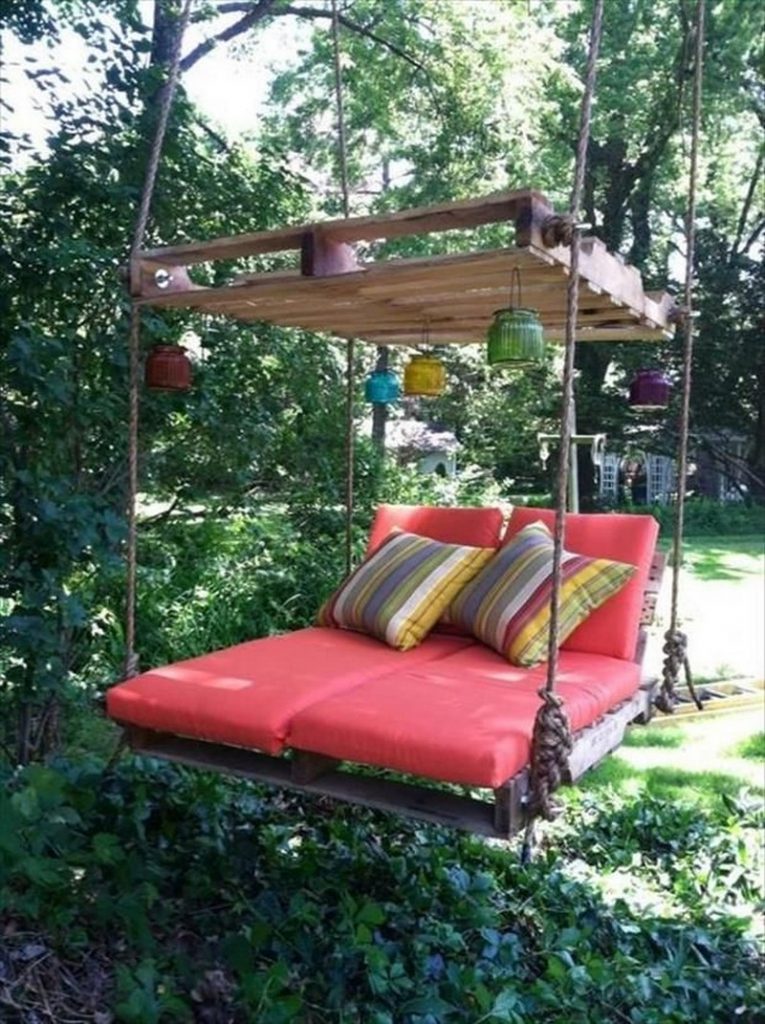
3. Next, take some rope or twine and tie it around the middle of the pallet. Make sure the rope is tight and secure. Once the rope is in place, take the other end and tie it around the front leg of the pallet. Again, make sure the rope is tight and secure. This will help to keep the pallet together when you’re moving it.
4. Now, take the ends of the rope and tie them to a nearby tree or other sturdy objects. Make sure the knots are tight so the rope doesn’t come loose.
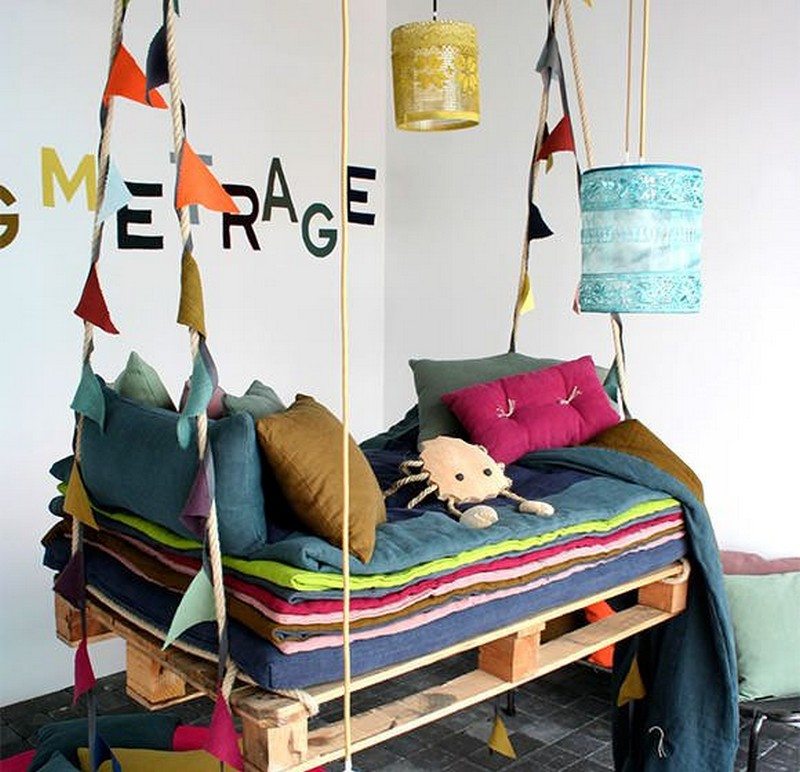
5. You can add a backrest to it so you can sit back and relax on it. Then add a mattress that fits, you can also bring in your favourite pillows and books. Your pallet swing bed is now ready to use!
6. You can enjoy your new bed for years to come, and it will be a great conversation piece for any guests that come over. This is the perfect swing bed for not just adults, but kids too! It’s so comfortable and relaxing, you’ll never want to leave it!
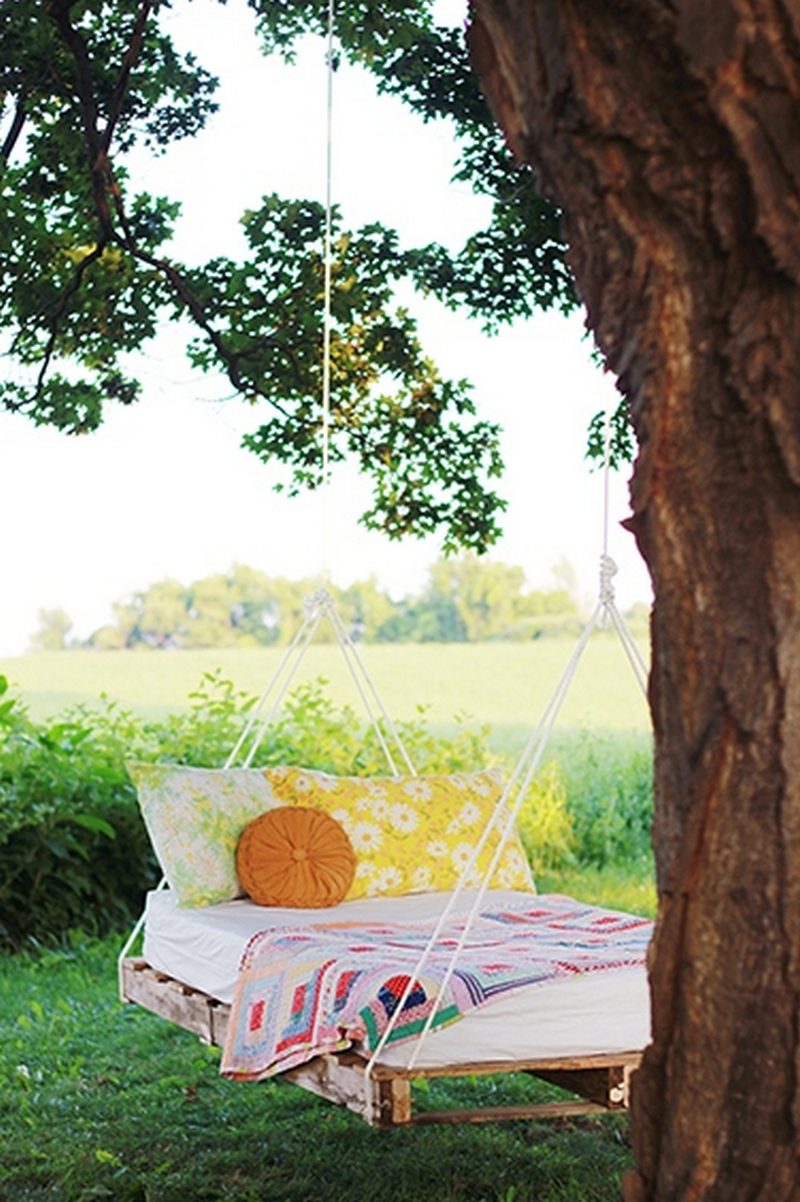
Go grab your favorite book and drink and let the neighbors envy your awesome outdoor furniture! You can relax in your swing and enjoy the warm weather while reading your book. Make sure to put on some sunscreen so you don’t get too sunburned!
If you’re looking for some inspiration, be sure to check out our gallery. It’s full of great examples of what you can do with your space.
What you’ll need to build a pallet swing bed…
Materials:
- Pallets
- 2×4 Lumber (3 8-ft pieces)
- Screws
- 700-lbs weight limit pro-grade Rope
- Mattress/Cushion
- 2-3 Vinyl Zippered Mattress Covers
Tools:
- Drill
- Measuring Tape
- Saw
Click on any image to start the lightbox display. Use your Esc key to close the lightbox. You can also view the images as a slideshow if you prefer 😎
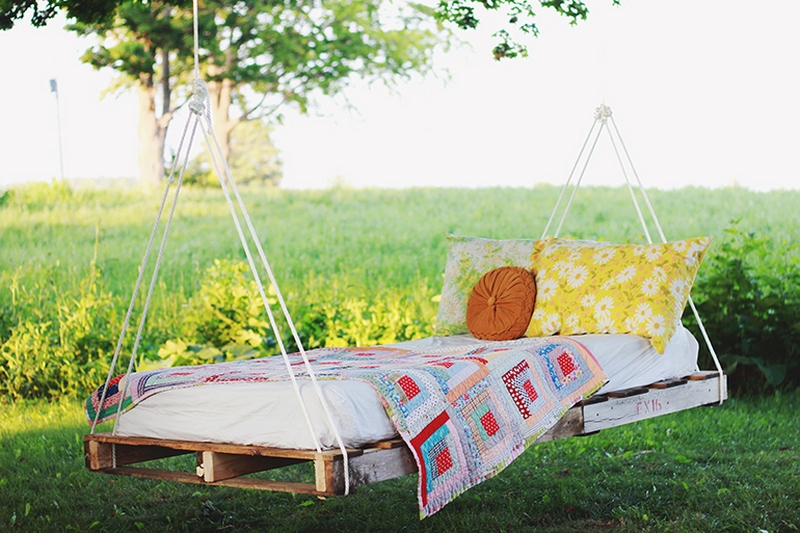
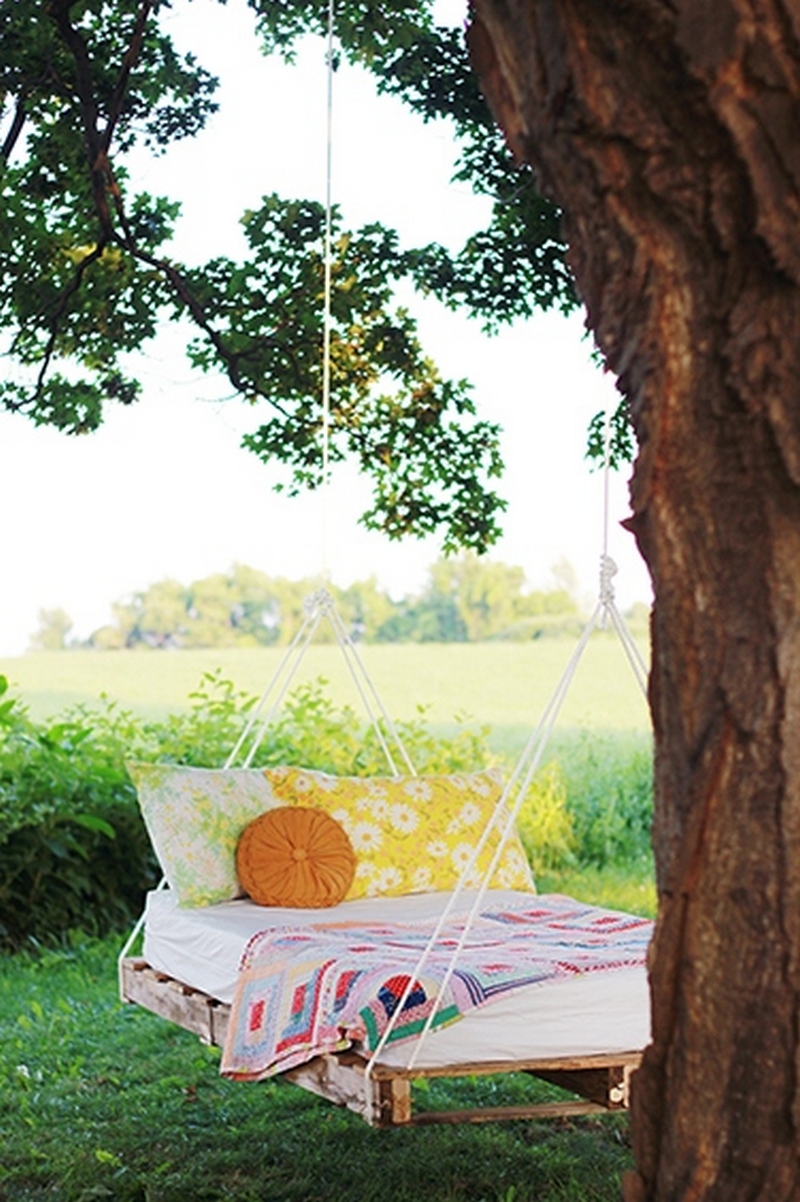
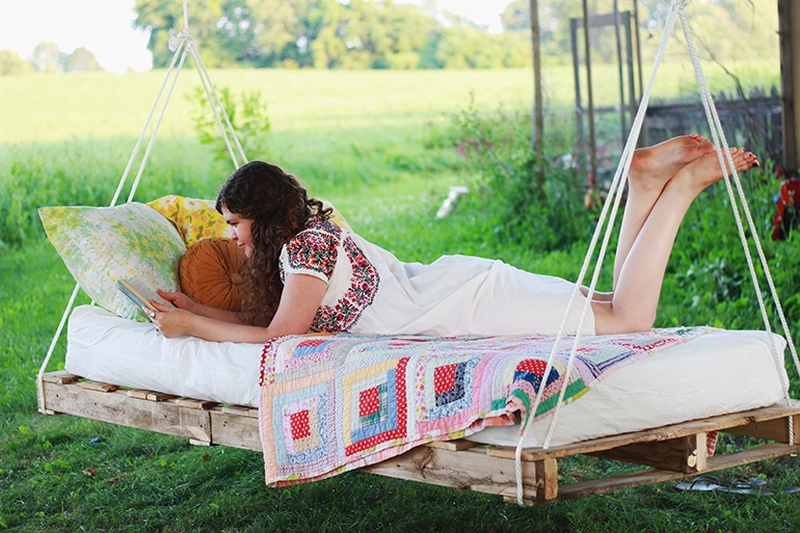

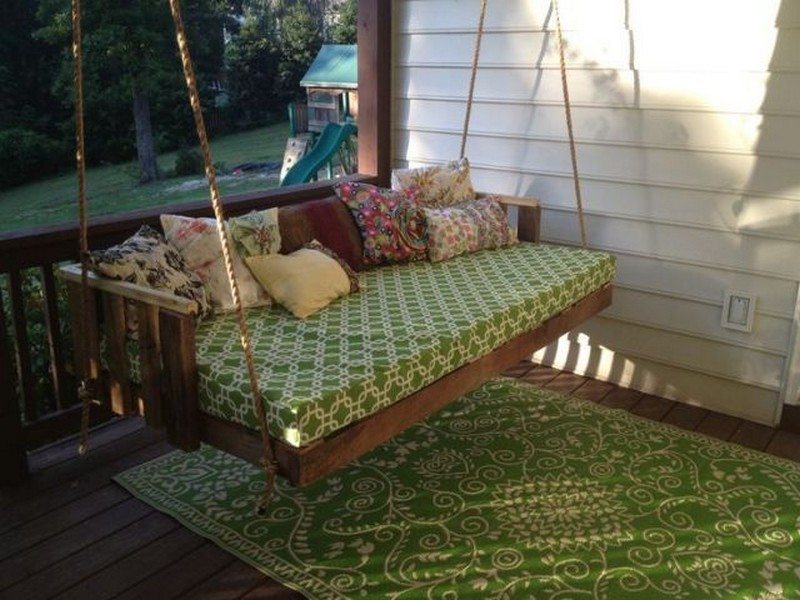
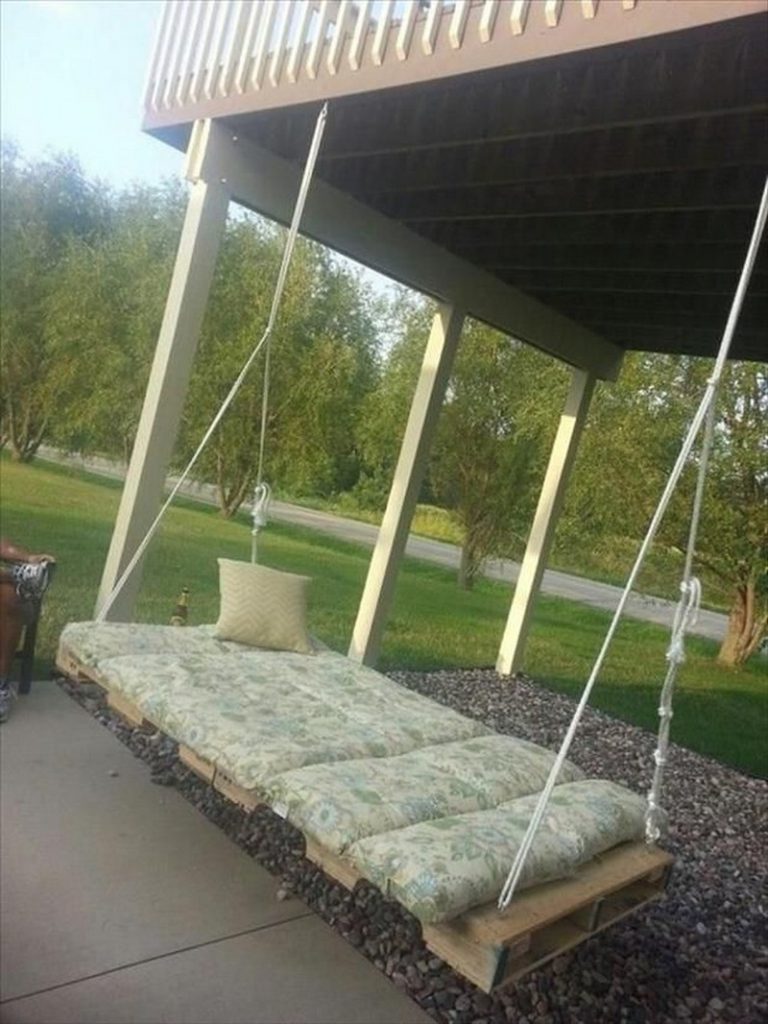


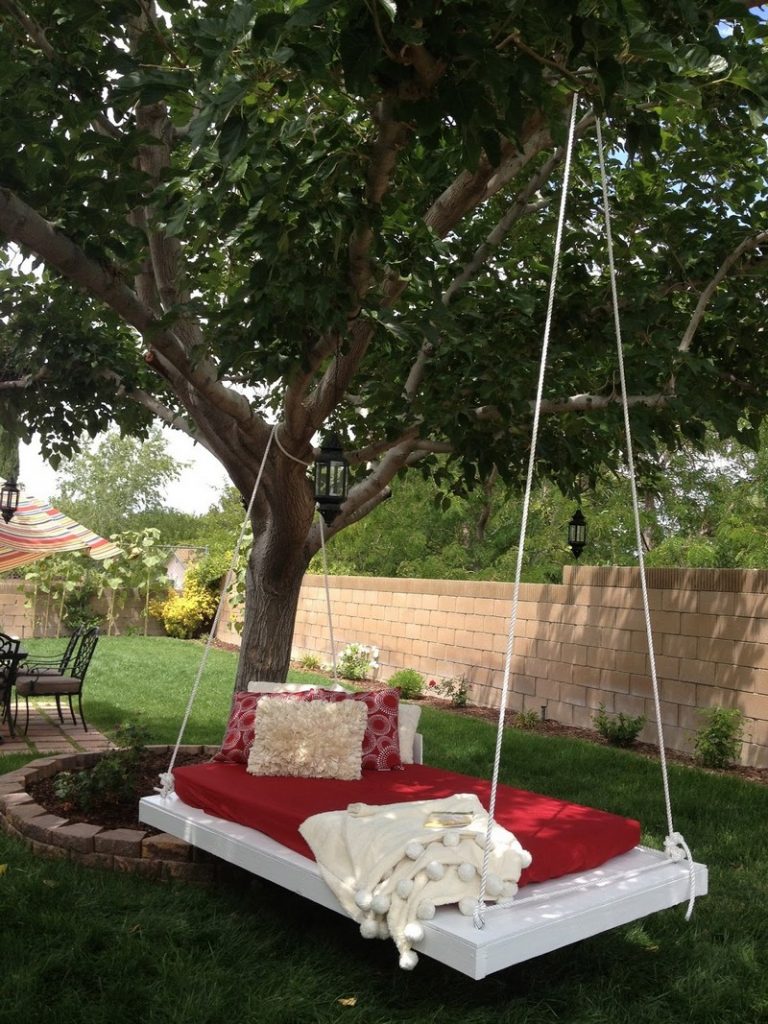
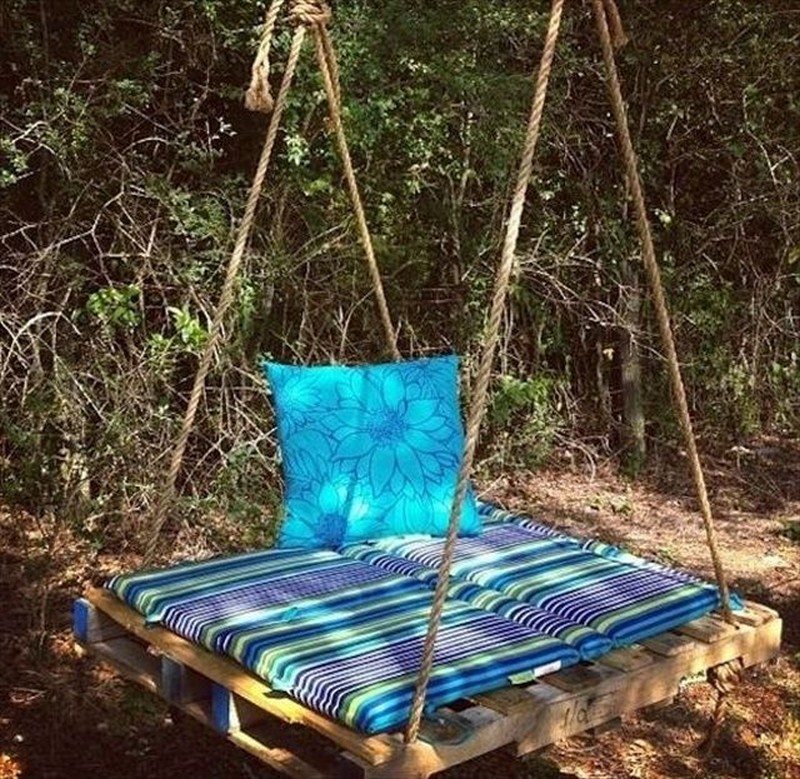

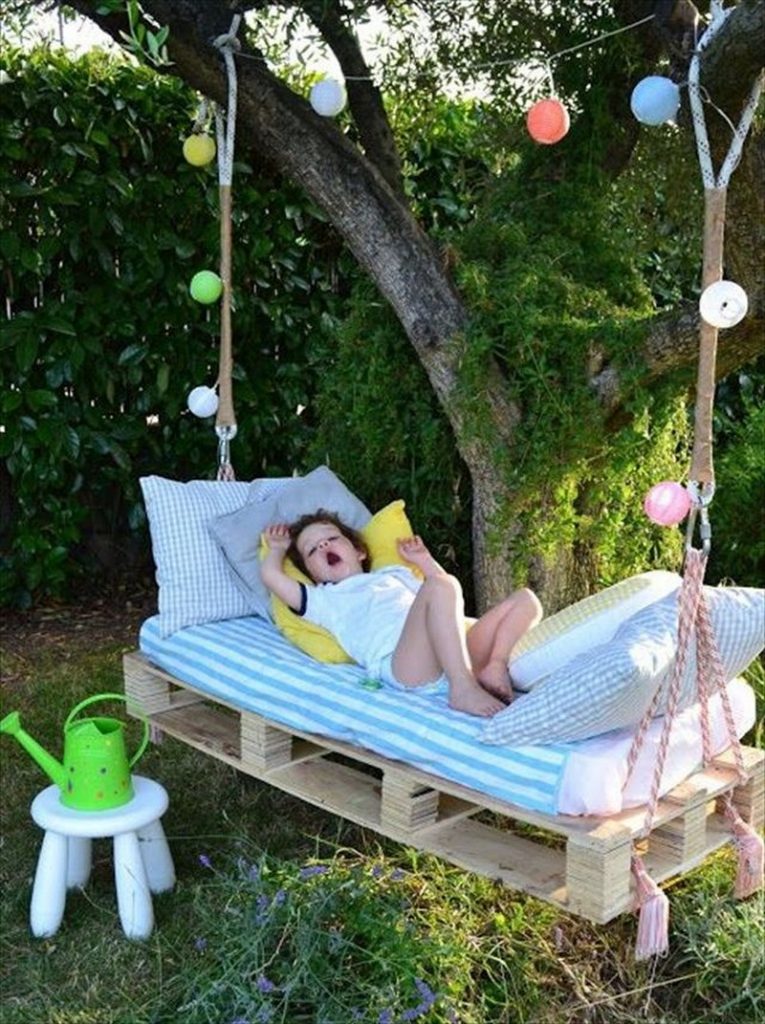
Thanks to The Merry Thought for sharing tips and strategies on how to make a DIY pallet swing bed.
If you liked this project, you will also like viewing these swings and hammocks…
Building a pallet swing bed is an exciting DIY project that can add both functionality and charm to your outdoor space. However, to ensure a successful outcome and a sturdy final product, it’s important to employ professional strategies throughout the construction process.
These strategies will help you overcome challenges, avoid common pitfalls, and create a high-quality swing bed that you can enjoy for years to come. Here are some pro strategies to consider when building a pallet swing bed:
1. Thorough Planning and Preparation
Before you begin construction, it’s crucial to invest time in thorough planning and preparation. Start by carefully measuring the space where you plan to install the swing bed and determining the desired size and dimensions.
Consider factors such as the weight capacity, the number of people the swing bed will accommodate, and any additional features you want to incorporate. Sketch out your design and create a detailed plan that outlines the materials needed, assembly steps, and any modifications or adjustments required.
2. Select High-Quality Materials
The quality of the materials you use will significantly impact the durability and longevity of your pallet swing bed. Choose sturdy pallets that are free from rot, mould, and insect damage, and ensure that they are of uniform size and thickness.
Opt for pressure-treated lumber for the frame and hardware that is corrosion-resistant and suitable for outdoor use. Investing in high-quality materials will help ensure that your swing bed withstands the elements and remains sturdy and reliable over time.
3. Proper Assembly Techniques
When assembling your pallet swing bed, it’s important to use proper techniques to ensure stability and structural integrity. Start by securely fastening the pallets together using screws or bolts, making sure to align them evenly and securely.
Reinforce the joints with additional bracing or supports as needed to prevent wobbling or shifting. Pay attention to weight distribution and balance to ensure that the swing bed can safely support the intended load without tipping or collapsing.
4. Consider Safety Factors
Safety should always be a top priority when building any DIY project, including a pallet swing bed. Be mindful of potential hazards such as sharp edges, protruding nails or screws, and unstable structures. Sand down any rough edges or surfaces to prevent splinters, and use safety equipment such as gloves and goggles when handling tools and materials.
If children will be using the swing bed, consider installing safety features such as railings or guardrails to prevent falls or accidents.
5. Weatherproofing and Maintenance
To ensure the longevity of your pallet swing bed, it’s important to weatherproof the wood and protect it from the elements. Apply a weatherproofing sealant or outdoor paint to the wood to prevent moisture damage, rot, and decay.
Regularly inspect the swing bed for signs of wear and tear, such as loose screws or damaged wood, and make any necessary repairs or replacements promptly. Additionally, consider covering the swing bed with a tarp or outdoor furniture cover during inclement weather to further protect it from damage.
6. Personalize and Customize
One of the advantages of building your pallet swing bed is the opportunity to personalize and customize it to suit your preferences. Get creative with paint or stain to add colour and personality to the wood, or incorporate decorative elements such as cushions, pillows, or canopy covers to enhance comfort and style.
Consider adding hooks or shelves for storage, or installing lights or speakers for added ambience. Let your imagination run wild and create a pallet swing bed that reflects your unique taste and personality.
By following these pro strategies, you can ensure a successful and satisfying experience when building your pallet swing bed. With careful planning, quality materials, proper assembly techniques, and attention to safety and maintenance, you can create a beautiful and functional outdoor retreat that you’ll enjoy for years to come.
The Wrap Up
Building the perfect DIY pallet swing bed is not just about creating a comfortable and stylish outdoor retreat; it’s also about the satisfaction of completing a rewarding project and enjoying the fruits of your labour.
Throughout the six fun steps of construction, you’ve put in the time, effort, and creativity to transform basic materials into a functional and inviting piece of furniture. Now, as you put the finishing touches on your swing bed and prepare to relax in its embrace, it’s time to reflect on the journey and celebrate your achievement.
As you stand back and admire your completed pallet swing bed, take a moment to revel in the sense of achievement and satisfaction that comes with completing a DIY project. You’ve taken raw materials and transformed them into a beautiful and functional piece of furniture that you can be proud of. The process may have had its challenges and setbacks, but overcoming them only adds to the sense of accomplishment.
Building a pallet swing bed requires creativity and ingenuity, as you find ways to repurpose and reimagine ordinary materials into something extraordinary. From designing the layout and structure to selecting the perfect cushions and accessories, every decision you’ve made has been a testament to your creativity and resourcefulness. Embrace the opportunity to express your style and make the swing bed uniquely yours.
Your pallet swing bed isn’t just a piece of furniture; it’s a gathering place where you can spend quality time with loved ones and create lasting memories together. Whether you’re sharing a leisurely afternoon with family, enjoying a romantic evening with your partner, or simply curling up with a good book, the swing bed provides a cozy and intimate space to connect and bond with those who matter most.
One of the greatest joys of having a pallet swing bed is the opportunity to relax and renew your spirits whenever you need a break from the stresses of daily life. Whether you’re seeking solitude and contemplation or simply a place to unwind and recharge, the swing bed offers a sanctuary where you can escape the hustle and bustle of the world and find peace and tranquility.
As you enjoy your pallet swing bed, remember that the possibilities for customization and personalization are endless. From adding decorative accents and accessories to experimenting with different cushion colours and patterns, you can continually update and refresh your swing bed to suit your changing tastes and preferences. Embrace the opportunity to get creative and make your swing bed truly one-of-a-kind.
Building the perfect DIY pallet swing bed in six fun steps is a rewarding and fulfilling experience that offers a host of benefits, from creative expression and connection with nature to relaxation and quality time with loved ones. As you enjoy your swing bed, take pride in the achievement of bringing your vision to life and savour the moments of tranquility and joy it brings. With your newfound outdoor oasis, you’ll have a place to retreat, recharge, and create lasting memories for years to come.
Frequently Asked Questions
1. How do you choose the right pallets for the pallet swing bed project?
Look for pallets that are in good condition, with no signs of damage or rot. Make sure they’re clean and free from any chemicals or contaminants that could be harmful to your health.
2. Do I need to treat or seal the pallets before using them?
It’s a good idea to sand the pallets to remove any rough edges or splinters and to seal them with an outdoor sealant or paint to protect them from the elements and prolong their lifespan.
3. How do you attach the pallets to form the swing bed?
You can use screws to secure the pallets together in a rectangular shape, making sure they’re aligned and evenly spaced. Reinforce the joints with additional support if needed to ensure stability.
4. How do you hang the pallet swing bed securely?
Drill holes in the corners of the swing bed frame and thread the rope through them, tying secure knots to hold the bed in place. Make sure the knots are tight and the rope is securely anchored to a sturdy overhead support structure, such as a strong tree branch or pergola.
5. Can you customize the design of the pallet swing bed?
Absolutely! You can customize the swing bed to suit your preferences by adding decorative elements, such as cushions, pillows, or even a canopy for shade. Get creative and make it your own!
6. How do you ensure the pallet swing bed is safe to use?
Check the integrity of the pallets and ropes regularly to ensure they’re in good condition and free from any signs of wear or damage. Avoid overloading the swing bed with too much weight, and always supervise children when they’re using it.
7. Can you use the pallet swing bed indoors?
While the swing bed is designed for outdoor use, you can certainly install it indoors if you have enough space and a sturdy overhead support structure to hang it from. Just make sure to secure it properly to prevent accidents.
8. How do you clean and maintain the pallet swing bed?
Regularly clean the swing bed with a mild detergent and water to remove dirt and debris. Check the ropes and hardware for signs of wear and tear, and replace them if necessary to ensure the swing bed remains safe and functional.
9. What weight limit does the swing bed support?
The swing bed should be able to support up to 700 pounds, but it’s essential to check the weight limit of the ropes and hardware you’re using and ensure they’re rated for the intended load.








